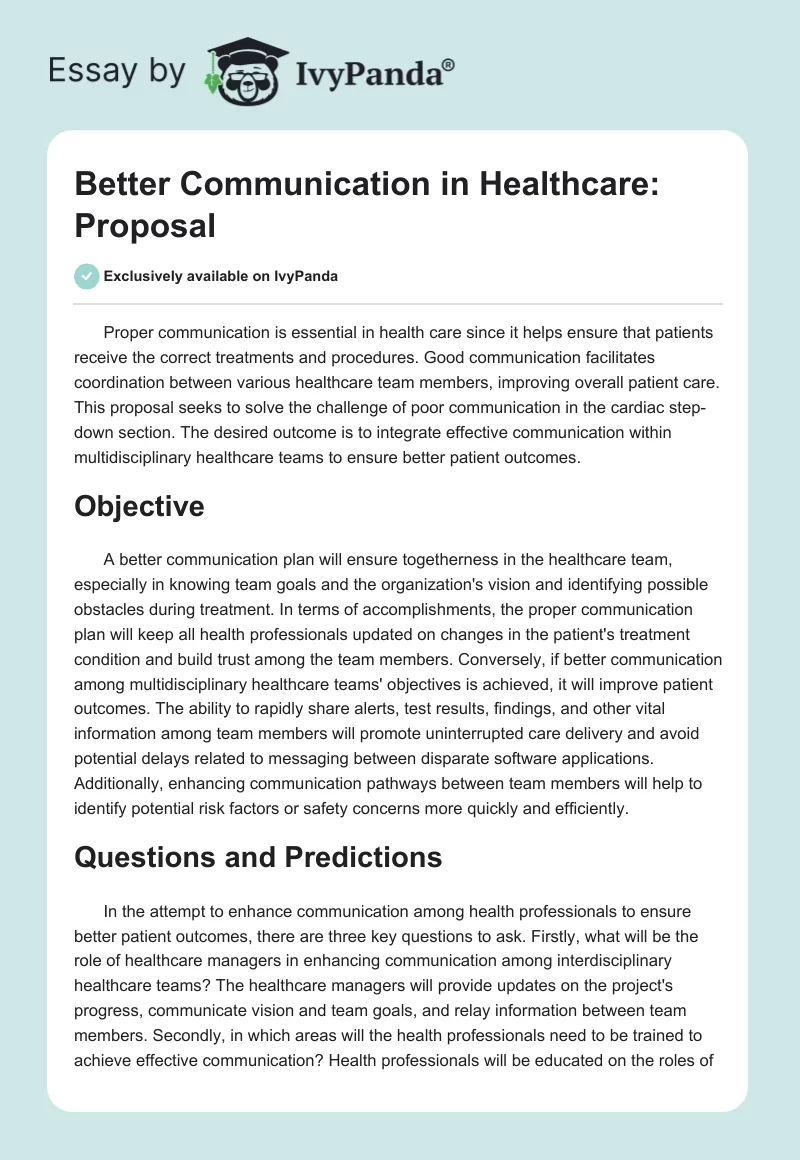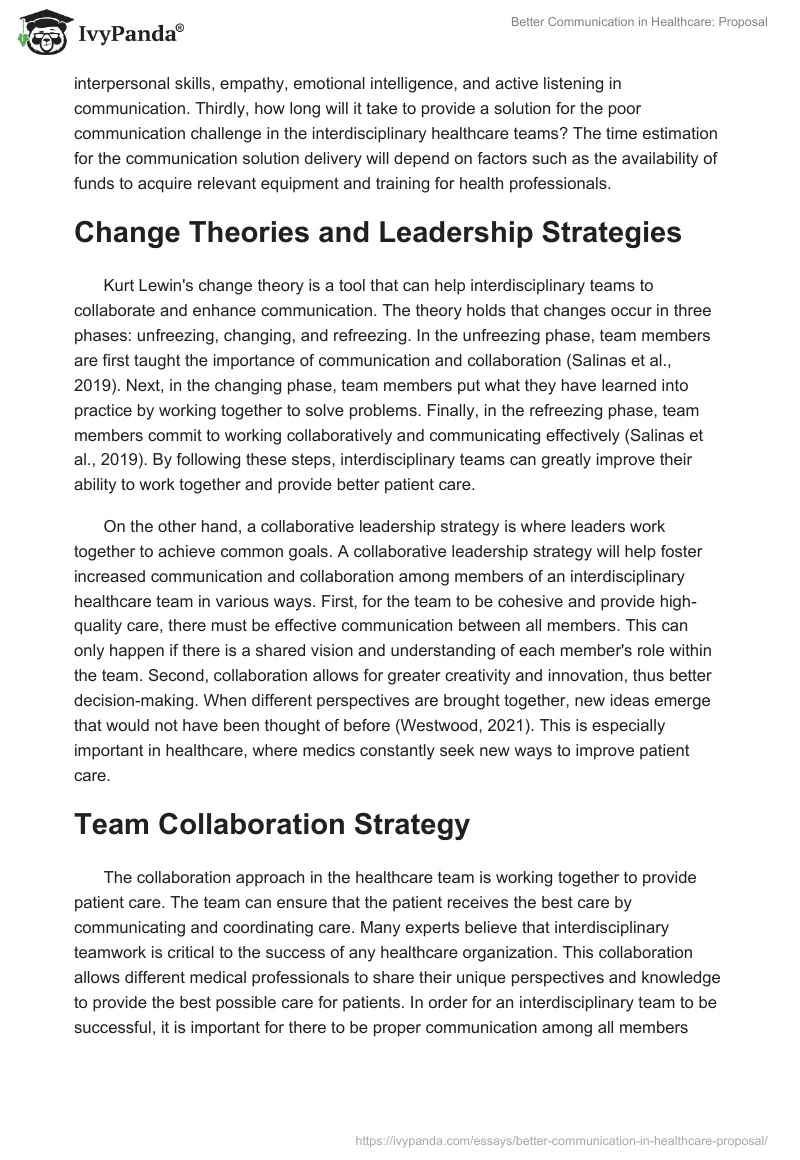Proper communication is essential in health care since it helps ensure that patients receive the correct treatments and procedures. Good communication facilitates coordination between various healthcare team members, improving overall patient care. This proposal seeks to solve the challenge of poor communication in the cardiac step-down section. The desired outcome is to integrate effective communication within multidisciplinary healthcare teams to ensure better patient outcomes.
Objective
A better communication plan will ensure togetherness in the healthcare team, especially in knowing team goals and the organization’s vision and identifying possible obstacles during treatment. In terms of accomplishments, the proper communication plan will keep all health professionals updated on changes in the patient’s treatment condition and build trust among the team members. Conversely, if better communication among multidisciplinary healthcare teams’ objectives is achieved, it will improve patient outcomes. The ability to rapidly share alerts, test results, findings, and other vital information among team members will promote uninterrupted care delivery and avoid potential delays related to messaging between disparate software applications. Additionally, enhancing communication pathways between team members will help to identify potential risk factors or safety concerns more quickly and efficiently.
Questions and Predictions
In the attempt to enhance communication among health professionals to ensure better patient outcomes, there are three key questions to ask. Firstly, what will be the role of healthcare managers in enhancing communication among interdisciplinary healthcare teams? The healthcare managers will provide updates on the project’s progress, communicate vision and team goals, and relay information between team members. Secondly, in which areas will the health professionals need to be trained to achieve effective communication? Health professionals will be educated on the roles of interpersonal skills, empathy, emotional intelligence, and active listening in communication. Thirdly, how long will it take to provide a solution for the poor communication challenge in the interdisciplinary healthcare teams? The time estimation for the communication solution delivery will depend on factors such as the availability of funds to acquire relevant equipment and training for health professionals.
Change Theories and Leadership Strategies
Kurt Lewin’s change theory is a tool that can help interdisciplinary teams to collaborate and enhance communication. The theory holds that changes occur in three phases: unfreezing, changing, and refreezing. In the unfreezing phase, team members are first taught the importance of communication and collaboration (Salinas et al., 2019). Next, in the changing phase, team members put what they have learned into practice by working together to solve problems. Finally, in the refreezing phase, team members commit to working collaboratively and communicating effectively (Salinas et al., 2019). By following these steps, interdisciplinary teams can greatly improve their ability to work together and provide better patient care.
On the other hand, a collaborative leadership strategy is where leaders work together to achieve common goals. A collaborative leadership strategy will help foster increased communication and collaboration among members of an interdisciplinary healthcare team in various ways. First, for the team to be cohesive and provide high-quality care, there must be effective communication between all members. This can only happen if there is a shared vision and understanding of each member’s role within the team. Second, collaboration allows for greater creativity and innovation, thus better decision-making. When different perspectives are brought together, new ideas emerge that would not have been thought of before (Westwood, 2021). This is especially important in healthcare, where medics constantly seek new ways to improve patient care.
Team Collaboration Strategy
The collaboration approach in the healthcare team is working together to provide patient care. The team can ensure that the patient receives the best care by communicating and coordinating care. Many experts believe that interdisciplinary teamwork is critical to the success of any healthcare organization. This collaboration allows different medical professionals to share their unique perspectives and knowledge to provide the best possible care for patients. In order for an interdisciplinary team to be successful, it is important for there to be proper communication among all members (Mulvale et al., 2016). This includes verbal and non-verbal communication; each team member must share information openly and listen to others to ensure togetherness.
Additionally, team members need to respect each other’s input and expertise. The team should also collaborate to develop evidence-based care plans for their patients. For this to happen, everyone on the team must be aware of their roles and expectations. Furthermore, a positive work environment is necessary for team members to feel comfortable communicating with one another (Mulvale et al., 2016). Collaboration among health professionals is critical to enhancing communication and driving success. By working together, healthcare professionals can share best practices, brainstorm solutions to common problems, and improve patient care. Additionally, collaboration can help build trusting relationships among team members, leading to greater efficiency and productivity. The entire team benefits when every employee works together towards a common goal. Furthermore, successful collaboration requires trust, respect, and clear communication (Mulvale et al., 2016). In order to build trust, team members need to feel comfortable communicating with each other and sharing information. Once trust is established, team members can start working together more effectively to drive success.
Required Organizational Resources
Specifically, there will be a need for staffing, such as a team of nurses to provide direct patient care and support, as well as doctors to coordinate patient care and manage the overall treatment plan. Similarly, social workers will aid patients and families in coping with emotional stress related to heart illness, while dietitians will provide nutritional counseling and guidance (Donelan et al., 2019). Likewise, pharmacists will monitor medication regimens and identify potential drug interactions, and occupational therapists will help patients adjust their daily routines.
Some of the equipment needed for the proposal to run successfully will include a cardiac monitor to keep track of a patient’s heart rate, rhythm, and blood pressure. An electrocardiogram machine will measure the heart’s electrical activity and help diagnose heart problems. Similarly, a stress test machine will be used to evaluate how well the heart works during physical stress (Lopes et al., 2017). Defibrillators will be used to restart a patient’s heart if it stops beating, while pacemakers will help regulate the heartbeat of patients with irregular rhythms. Other communication pieces of equipment and services that will be needed are office telephones, desk computers, and internet connectivity. These pieces of equipment will aid in faster and more accurate conduction of tests, thus allowing timely communication and treatment and saving patients’ lives. Among the items mentioned, the only lacking are the electrocardiogram, stress test machine, and defibrillator, which will cost $65, $350, and $1100, respectively. It will also be necessary to add office telephones and desktop computers, each at $200 and $350 respectively.
For a doctor to see a patient, they need access to the patient’s chart, which includes information such as the patient’s name, room number, date of birth, current medications, and any allergies. To access a patient, the doctors will need access to the hospital’s computer system and current status, and this will have no cost since the internet and computer will be freely available. If this proposal is unsuccessful, the organization’s resources will have been wasted, thus subjecting the organization to losses.
Budget
References
Donelan, K., Chang, Y., Berrett-Abebe, J., Spetz, J., Auerbach, D. I., Norman, L., & Buerhaus, P. I. (2019). Care management for older adults: The roles of nurses, social workers, and physicians.Health Affairs, 38(6), 941-949. Web.
Lopes, R. D., Alings, M., Connolly, S. J., Beresh, H., Granger, C. B., Mazuecos, J. B., Boriani, G., Nielsen, J. C., Conen, D., Hohnloser, S. H., Mairesse, G. H., Mabo, P., Camm, A. J., & Healey, J. S. (2017). Rationale and design of the apixaban for the reduction of thromboembolism in patients with device-detected sub-clinical atrial fibrillation (ARTESiA) trial.American Heart Journal, 189, pp. 137–145. Web.
Mulvale, G., Embrett, M., & Razavi, S. D. (2016). ‘Gearing Up’ to improve interprofessional collaboration in primary care: A systematic review and conceptual framework.BMC Family Practice, 17. Web.
Salinas, D., Johnson, S. C., Conrardy, J. A., Adams, T. L., & Brown, J. D. (2019). Sustaining nursing grand rounds through interdisciplinary teamwork and interorganizational partnership.The American Journal of Nursing, 119(4), 41–48. Web.
Westwood, M. (2021). Socially responsible diversity management: Collaborative leadership as management strategy.International Journal of Advance Research and Innovative Ideas in Education, 7(4), 900-902. Web.


